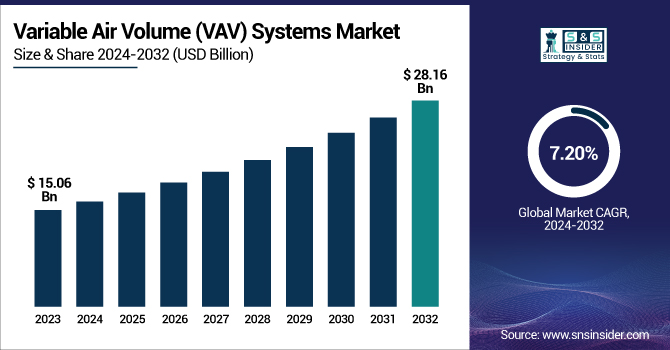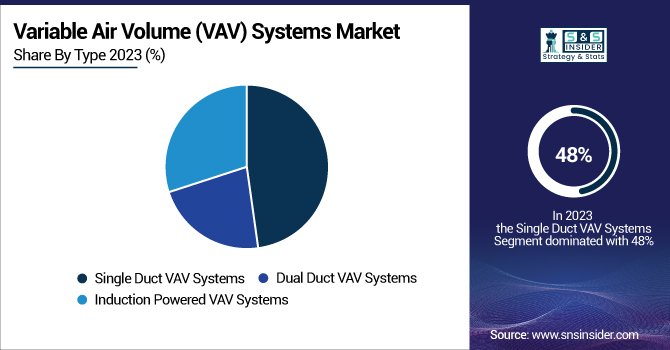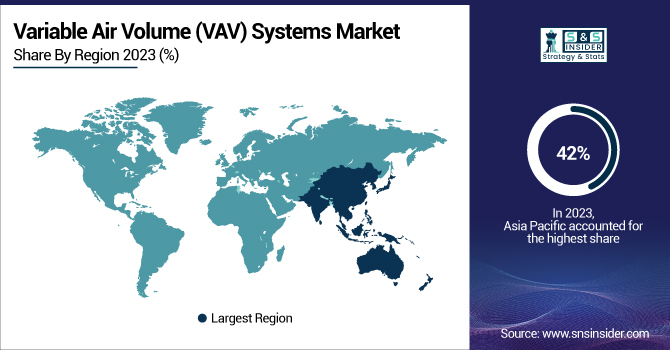Variable Air Volume (VAV) Systems Market Report Scope & Overview:
The Variable Air Volume (VAV) Systems Market Size was estimated at USD 15.06 billion in 2023 and is expected to arrive at USD 28.16 billion by 2032 with a growing CAGR of 7.20% over the forecast period 2024-2032. The Variable Air Volume (VAV) Systems Market has seen significant energy efficiency improvements, with retrofitting initiatives enhancing HVAC performance and cost savings. North America remains a key market, while Asia-Pacific is experiencing rapid adoption due to urbanization and sustainability goals. Innovations such as AI-driven airflow control, IoT-enabled predictive maintenance, and demand-based ventilation are driving technological advancements. Additionally, the growing focus on net-zero buildings and smart climate control solutions is shaping the future of VAV systems in modern infrastructure.

To Get more information on Variable Air Volume (VAV) Systems Market - Request Free Sample Report
Variable Air Volume (VAV) Systems Market Dynamics
Drivers
-
The growing adoption of VAV systems is driven by rising energy efficiency regulations, sustainability initiatives, and advancements in smart HVAC technology.
The growing demand for energy-efficient HVAC systems is a key driver for the Variable Air Volume (VAV) Systems market. Exponential growth in energy consumption, and increasing government rules are pushing VAV systems adoption further in commercial, industrial, and residential buildings. One highly influential technology that reduces power usage and operating expenses in addition to the superior indoor air quality and thermal comfort these systems provide are VAV systems by optimizing airflow in real time according to the demand. Apart from these, the market is also driven by changing building standards related to green buildings like LEED certification and ASHRAE standards towards sustainability initiatives from municipalities and states. Moreover, the integration of smart sensors, IoT-enabled controls, and AI-based automation refinements coupled with technological advancements are improving efficiency and energy optimization of VAV systems. An integrated suite of building management systems (BMS) is also emerging in the market which allows different systems to operate together and save energy. Due to the extensive commercial infrastructure and urbanization, the VAV systems market is expected to grow steadily as there is wide emphasis across the globe on energy conservation & carbon footprint reduction.
Restraint
-
The high initial cost of VAV systems, including installation and customization, limits adoption among SMEs despite long-term efficiency benefits.
The high initial investment and installation costs of Variable Air Volume (VAV) systems pose a significant challenge, particularly for small and medium-sized enterprises (SMEs). VAV systems cost more upfront since they need special components such as dampers, sensors, and controllers that you will not find in conventional HVAC systems. Furthermore, the installation process is quite difficult and generally necessitates the support of professionals to make all the necessary modifications based on your particular building and the airflow required. This makes them more expensive upfront than traditional constant air volume (CAV) systems. While costs may be recovered over time with energy savings and operational efficiencies, the high capital expenditure associated with VAV system deployment serves as a barrier to adoption for many SMEs operating on tighter budgets. In addition, if existing infrastructure needs to be upgraded to accommodate VAV systems, it may be necessary to make changes that could significantly add to cost. Although energy efficiency incentives and rebates offered in several countries reduce the cost of no-cost measures, upfront capital cost is still considered as a major barrier that restrains the market penetration rate, particularly in cost-sensitive sectors and developing countries.
Opportunities
-
Technological advancements in sensor-based controls, AI-driven air distribution, and automation are enhancing VAV system efficiency, reducing energy consumption, and driving market growth.
Technological innovations in HVAC systems are transforming the Variable Air Volume (VAV) market by enhancing efficiency, automation, and sustainability. Research on sensor-based controls, which include continuous measurement of airflow and temperature to ensure better energy utilization, is still ongoing to enhance indoor air quality. These help in creating an adaptive air distribution mechanism going with the flow of occupancy in the building and cutting down energy wastage, along with providing comfort. Automation, such as IoT driven VAV systems, helps a lot to integrate seamlessly with a smart building management system that can provide predictive maintenance and real-time control capabilities. Such improvements cut down the operating costs, while also making sure they meet energy efficiency regulations that are getting stricter as every day goes by. By analyzing usage patterns and automatically tuning settings, machine learning algorithms further boost system performance. The VAV Systems market will see exponential growth as industries and commercial building & factories are accelerating the shift to smart infrastructure, which is anticipated to stimulate innovation and expand the HVAC sector.
Challenges
-
Evolving energy regulations and certification requirements increase compliance costs and complexity for VAV system manufacturers and end-users.
Regulatory and compliance challenges in the Variable Air Volume (VAV) systems market stem from the evolving landscape of energy efficiency standards and environmental regulations. Governments around the globe regulate strict building codes , including standards like ASHRAE, LEED certification, and the European Union Energy Performance of Buildings Directive (EPBD) to ensure HVAC manufacturers have equipment with high-efficiency thresholds. Adherance to these regulations requires ongoing technology, thus pushing R&D expenses up for production. In addition, the long and expensive certification processes can cause delays for product launches and market entry. This means end-users must typically retrofit or upgrade existing HVAC systems to comply, which drives their investment cost. Companies have to adapt their product to each regional regulation and the fact that there are so many different regulations around the world makes it all much more complex! All of these regulations listed above pose challenges for VAV system manufacturers and consumers alike, balancing cost metrics while needing to apply binding regulatory frameworks into VAV applications.
Variable Air Volume (VAV) Systems Market Segmentation Analysis
By Type
The Single Duct VAV Systems segment dominated with a market share of over 48% in 2023, due to its extensive use in commercial buildings, including offices, hospitals, and educational institutions. Such systems are extremely popular due to the efficient control of air and thermal comfort with energy savings. They are ideal for large-scale applications due to their low component and maintenance requirements, making them a cost-effective solution when compared to other VAV systems. Also, HVAC innovation enhanced the preference for these devices along with a developing focus on energy efficiency. The market of single duct VAV systems is continuously increasing due to increasing demand for the sustainable and smart building solutions, which makes it the most significant part of the market.

By End-Use Vertical
The commercial segment dominated with a market share of over 42% in 2023, and is also the fastest-growing segment. As a result of the enormous use of VAV systems in commercial areas, including office buildings, shopping malls, hospitals, and hotels. Such systems deliver accurate environmental temperature control, improve indoor air quality, and offer excellent energy savings, with these being especially applicable to large-scale establishments. With an increasing focus on sustainability and energy efficiency in businesses, the demand for VAV systems is on the rise. Furthermore, their adoption is being accelerated by advancements in smart building technologies as well as rigorous energy regulations. Due to increasing focus on economical and energy efficient HVAC systems, the commercial segment is expected to dominate the VAV systems market during the forecast period.
By Application
The Air Filter segment holds a significant share in the Variable Air Volume (VAV) Systems Market due to its essential role in maintaining indoor air quality and ensuring efficient airflow. The concept of HVAC systems is becoming more advanced, which thus increases the demand for high-performance air filters due to the greater awareness towards air pollution and its effects on health. The adoption of technologically advanced filtration systems is further fueled by stringent air quality regulations and sustainability initiatives. And commercial sectors like healthcare, commercial buildings, and manufacturing require improved air filtration to meet safety and environmental regulations. The increasing demand for the energy consumption of HVAC components is one of the key factors that will drive growth in the air filter market in the coming years.
Variable Air Volume (VAV) Systems Market Regional Outlook
The Asia-Pacific region dominated with a market share of over 42% in 2023, primarily due to rapid urbanization and expanding commercial infrastructure. In countries such as China, India, and Japan, the development of office spaces, shopping malls, and industrial plants is on the rise, leading to a further increase in demand for HVAC solutions. Moreover, government policies focused on establishing energy-efficient buildings and sustainable practices of construction further aid the market growth. Increasing awareness regarding indoor air quality and demand for economic climate control solutions is also promoting growth. Another reason for the dominance of the region can be attributed to the technological innovations such as smart and connected HVAC systems incorporated through automation and the Internet of Things (IoT). The Asia-Pacific market will continue its leadership through investments in infrastructure development, and strict energy regulations.
Europe is experiencing the fastest growth in the Variable Air Volume (VAV) Systems Market due to stringent energy efficiency regulations and the increasing adoption of smart building solutions. The institution of strict policies by several governments across the region, for reduction of carbon emissions, is encouraging the use of energy-efficient HVAC systems such as VAV. Moreover, the increasing focus on sustainable development and the green building standards, such as BREEAM and LEED, are juga memacu permintaannyan. The market is additionally benefited by technological advancements such as IoT-enabled climate control and automation. Growth is also driven by the increasing adoption of smart infrastructure and retrofitting projects in commercial buildings. The demand for such solutions in Europe is anticipated to keep experiencing positive market growth in the upcoming years due to the growing focus on energy conservation and sustainability-focused goals.

Get Customized Report as per Your Business Requirement - Enquiry Now
Some of the major key players in the Variable Air Volume (VAV) Systems Market
-
Honeywell International Inc. (VAV Controllers, Smart Thermostats)
-
Carrier Corporation (VAV Air Terminals, HVAC Control Systems)
-
Johnson Controls (VAV Boxes, Building Automation Systems)
-
Warren Technologies (Electric Duct Heaters, VAV Terminals)
-
Emerson Electric Co. (HVAC Control Solutions, Actuators)
-
Siemens (VAV Compact Controllers, Damper Actuators)
-
TROX GmbH (VAV Terminal Units, Air Volume Controllers)
-
Swegon Group AB (VAV Diffusers, Climate Control Systems)
-
Triton Process Automation Pvt. Ltd. (VAV Control Panels, HVAC Automation Solutions)
-
Trane (VAV Terminal Units, Air Handling Systems)
-
Daikin Industries Ltd. (VAV Air Handlers, HVAC Controls)
-
Lennox International Inc. (VAV Rooftop Units, Airflow Systems)
-
Schneider Electric (VAV Controllers, Smart Building Solutions)
-
Belimo Holding AG (Damper Actuators, VAV System Sensors)
-
Greenheck Fan Corporation (VAV Diffusers, Air Distribution Systems)
-
Price Industries (VAV Boxes, Airflow Control Systems)
-
United Technologies Corporation (VAV Terminals, Energy Management Systems)
-
Mitsubishi Electric Corporation (VAV Controllers, HVAC Energy Solutions)
-
Ruskin Company (VAV Dampers, Air Control Solutions)
-
Krueger HVAC (VAV Terminal Units, Air Distribution Products)
Suppliers for (advanced VAV systems with smart controls and energy-efficient solutions for commercial buildings) on the Variable Air Volume (VAV) Systems Market
-
Johnson Controls
-
Ingersoll Rand Plc.
-
Daikin Industries, Ltd.
-
United Technologies Corporation
-
Emerson Electric Co.
-
Honeywell International Inc.
-
Siemens
-
TROX GmbH
-
KMC Controls
-
Barcol-Air
Recent Development
On October 3, 2024: Trane introduced its redesigned Precedent Rooftop Unit portfolio, along with enhancements to its unitary, split system, and VAV products. These upgrades focus on decarbonization, incorporating low-GWP refrigerants to support building owners and engineers in adopting more sustainable HVAC solutions.
On March 7, 2024: Schneider Electric launched its EasyLogic Building Management System (BMS) range, tailored for basic building architectures. This cost-effective solution features field controllers and sensors for HVAC applications, enhancing installation efficiency and energy management while maintaining Schneider Electric's trusted reliability.
| Report Attributes | Details |
|---|---|
| Market Size in 2023 | USD 15.06 Billion |
| Market Size by 2032 | USD 28.16 Billion |
| CAGR | CAGR of 7.20% From 2024 to 2032 |
| Base Year | 2023 |
| Forecast Period | 2024-2032 |
| Historical Data | 2020-2022 |
| Report Scope & Coverage | Market Size, Segments Analysis, Competitive Landscape, Regional Analysis, DROC & SWOT Analysis, Forecast Outlook |
| Key Segments | • By Type (Single Duct VAV Systems, Dual Duct VAV Systems, Induction Powered VAV Systems) • By End-use Vertical (Residential, Industrial, Commercial, Others) • By Application (Air Filter, Heating & Cooling Coil, Fan (Inlet & Outlet), Diffuser, Damper & Air Handler, Radiator, Thermostat, Others (Sensors & Inductors) |
| Regional Analysis/Coverage | North America (US, Canada, Mexico), Europe (Eastern Europe [Poland, Romania, Hungary, Turkey, Rest of Eastern Europe] Western Europe] Germany, France, UK, Italy, Spain, Netherlands, Switzerland, Austria, Rest of Western Europe]), Asia Pacific (China, India, Japan, South Korea, Vietnam, Singapore, Australia, Rest of Asia Pacific), Middle East & Africa (Middle East [UAE, Egypt, Saudi Arabia, Qatar, Rest of Middle East], Africa [Nigeria, South Africa, Rest of Africa], Latin America (Brazil, Argentina, Colombia, Rest of Latin America) |
| Company Profiles | Honeywell International Inc., Carrier Corporation, Johnson Controls, Warren Technologies, Emerson Electric Co., Siemens, TROX GmbH, Swegon Group AB, Triton Process Automation Pvt. Ltd., Trane, Daikin Industries Ltd., Lennox International Inc., Schneider Electric, Belimo Holding AG, Greenheck Fan Corporation, Price Industries, United Technologies Corporation, Mitsubishi Electric Corporation, Ruskin Company, Krueger HVAC. |

